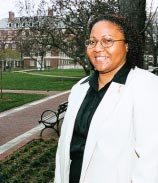
“I’m just a regular person doing my job,” says Georgette Gaskin ’90. Well, maybe. In February, she was named 2002 Black Engineer of the Year in the category of Outstanding Technical Contribution in Government. The award honors Gaskin’s leadership of the adhesives and sealants team for the Navy’s aircraft division. Sponsored by Lockheed Martin Corporation and other groups, the Black Engineer of the Year conference has become a premier event for African-Americans in engineering, science, and technology.
This year marks the second time in Gaskin’s 12-year career that she has received this national award. Five years ago, she was honored in the category of Most Promising. In 2002, one might say, she won for promises fulfilled.
In high school, the St. Louis native was attracted to Johns Hopkins University because of her interest in biomedical engineering. But once enrolled at the Whiting School, she “fell in love” with airplanes. She began asking her advisor more questions about materials science and engineering. “Most of my friends were doing double majors anyway,” she says. “My advisor told me that if I could handle the work, I should go ahead,” and she did. Materials science is at the heart of aerospace engineering because of the quest for stronger, lighter, and longer-lasting aircraft.
“I initially loved to work hands-on in the lab, and I thought I would always want to do research,” says the civilian aerospace engineer from her office at the Naval Air Station, Patuxent River in southern Maryland. It’s the home of NAVAIR (the U.S. Naval Air Systems Command), which oversees the Navy’s air operations.
“To make aircraft lighter and stronger, we try to bind rather than connect parts… using traditional connecting methods such as riveting can compromise the structural integrity.”
Gaskin’s career began in metallurgy for aircraft applications, but soon turned to developing polymers for structural adhesive bonding. “To make aircraft lighter and stronger, we try to bind rather than connect parts,” she explains, “because using traditional connecting methods such as riveting can compromise the structural integrity” of the ultra-thin skins of military aircraft.
Her patent on a surface preparation for stainless steel that improved its adherence capabilities led to more research funding and “more people working under me,” she says. And that brought her “more responsibilities as team and project leader.”
Gaskin’s leadership qualities also have been nurtured through her drive to help young women gain confidence, choose engineering as a career, and network early on. In the ’90s, she served as president for four years of the Philadelphia chapter of the Association for Women in Science. “We would help with an annual cience fair for middle and high schools,” she says, as well as presentations at schools.
She’s well aware of the challenges she faces in a male-dominated profession. “One of the things I’ve noticed,” Gaskin says, warming to the topic, “is that, while you usually don’t hear a man being asked where he went to school, I get it all the time.” She laughs in recalling how much fun it is to let them know where she earned her degree. As a woman, “you do stand out,” she concedes. But, “with the Hopkins background, I have the technical competence and professional confidence to come right back at them.”
Gaskin believes that “You easily overcome the doubt of coworkers and colleagues by being technically competent. Hopkins was a big help because it’s such a tough program that it gave me plenty of strength to draw on.”
In February, Gaskin returned to campus for a visit. “I talked to engineering students, toured the Whiting School, and spoke to high school students at a Baltimore City public school,” she recalls.
For someone who seems to rise naturally to the top, Gaskin remains low-key about her goals: “I just want to continue to learn more about how the Navy works and help the fleet.”




